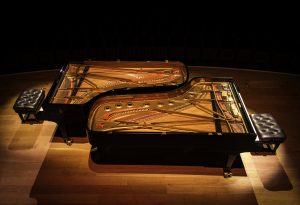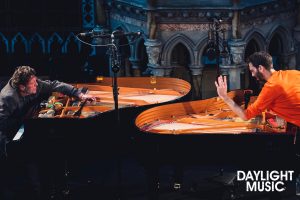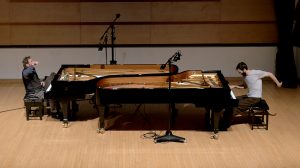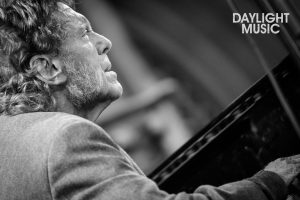Be ready, always: on working with Keith Tippett
April 9th, 2020ENTÊTE
This blog is a mixture of personal reflection, thoughts on process, on how working with Keith Tippett has helped reshape the topography of my piano/performance practice, and deserved praise for the work and pianism of one of the most significant musicians of our time.
BACKGROUND
Since discovering Keith Tippett’s music (Mujician I, II, III / Dedicated to You, But You Weren’t Listening / Septober Energy / Frames) as a student at Leeds College of Music in the late 1990s, I’ve been fascinated and stimulated by Keith’s musical universe. I remember one of our first meetings – he was a guesting with Stitch Winston’s Modern Surfaces, just over the road at The Wardrobe. I was part of a trio with bassist Riaan Vosloo, and drummer Dave Black – we played odd lunchtimes, and before most of the evening concerts organised by Leeds Jazz (usually in front of the main artists whilst they ate their pre-gig meal) – in exchange for £5, a little food, and free entry into the gigs downstairs. I saw Keith’s name in the programme, and prepared arrangements of a couple of his own compositions and included them in the set. Thanks to the supportive management at the time (James & Martin Hudson), we were given carte blanche and weren’t afraid of playing out or making more adventurous moves in this setting, and, as a trio, had mastered the subtle art of doing what we wanted musically; without upsetting any of the punters (avant-garde subterfuge). So, we did our thing. Sitting downstairs before the gig, I felt a hand on my shoulder and the words “Were you the piano player from upstairs?”. I confessed, and Keith then complemented me on the music, on not being afraid to play more adventurous stuff on a restaurant gig, and generally reaching out in support of what we were up to. To have confirmation that we were on the right track from someone like Keith, was huge.
Over the years, Keith and I continued to meet at gigs, chat about music, and even once Keith phoned me at home after listening to a recording of a 2003 Bath Jazz Festival commission with Bourne Davis Kane; offering generous words of support. It wasn’t until we met by chance backstage at the 2016 Herts Jazz Festival that Keith suggested we do some playing together. I was travelling to London that evening, and met up the following day with John Cumming for a long-overdue pint… I mentioned the conversation with Keith, and wondered if anyone would be interested in hearing us play live – to which John responded with “Well, I would – how about a gig at Kings Place at London Jazz Festival next year?”.

RECALIBRATION
“There’s too much directing going on around here” – Orson Welles
Keith and I had arranged to meet up in Bristol once a month for several months leading up to the 2017 LJF concert. Initially, I was daunted by the prospect of playing with someone whose approach to piano playing I so admired, and had stolen (or at least attempted) so much from. Our first musical meeting, after several afternoons of conversation at Keith’s home, took place at The Victoria Rooms under the auspices of Bristol University, and set the format for all subsequent occasions: playing, conversation, playing, tea break/conversation, playing, etc.
I recall the very first few minutes of playing together and immediately realised that something unfamiliar was occurring, internally. I found myself shunted from my usual ‘place’ into another dimension altogether: suddenly there was no room for superficiality of any kind, and the conscious directorial prompts usually present in these situations (“do this” / “do that” / “go here next” / “damn – I should have warmed up as I can’t articulate myself clearly – and sound shit” / “that’s Keith Tippett sitting over there, and I can’t be fucking about…”), were unbearably loud and intrusive. They were not the TRUTH of the situation. I had been unaware as to how loud these internal prompts had become, and amazed at how active and alive they are in their guise as comforting whispers as part of my practice both on and offstage.
Unearthing these interruptions prompted a need to confront and reevaluate their function: What are they doing for me now? What use are they? and ultimately – Are they the truth? Probably not. My hunch is that these are leftovers – mental artefacts that were an important part of a highly frenetic thought processes that informed my earlier solo work, where Zorn-like musical jump cuts were a prominent feature, and ‘fifth gear’ thinking ahead to the next texture/gesture/sample/technique, was an absolute necessity for the effectiveness of musical execution. In this particular setting, there seemed neither use nor room for them, and have watched them gradually still, transmute themselves into more useful characteristics, or become muted altogether. Whatever is happening, I don’t wish to observe too closely, nor consciously action my evaluations onto/into the processes that are naturally unfolding. Cue Orson Welles…
COMMUNION
Typically, Keith and I would naturally play for around twenty/twenty-five minutes a session, with around three sessions in each meeting. Before our first concert in London, we were kindly given access to Colston Hall, Bristol, on a Sunday afternoon. Filmed by Ray Kane, the session below is a rare and intimate excerpt of this meeting, and illustrates the emergence of a burgeoning musical synergy.
Having now played with Keith a number of times, I was beginning to intimately understand the range and scale of Keith’s dedication to the instrument through daily practice. Note that this work does not make its appearance by way of quotation or verbatim account (incidentally, neither of us ‘practice’ improvisation at home). One example of this can be found on the re-release of Keith’s seminal, and largely overlooked solo piano album, The Unlonely Raindancer. The titles on this album were taken from a series of recordings that were made on a solo tour of The Netherlands in 1979. They are unmatched in their musical imaginativeness and pianistic virtuosity. Even more startling is that these pieces are only fragments of a much larger whole: whilst on tour, Keith was playing three sets a night for almost a fortnight, with each set averaging from twenty-five to forty minutes in duration. The title track is taken from a single thirty-minute set, and (on the album), concludes as things are beginning to pick up in the context of the full set:
Alongside the transmutation of practice-specific work into a more spontaneous-sounding language in performance, are the often shorter, gestural ‘thumbprints’ each musician possesses that also find their way into a performance. The presence of a lexicon of techniques or favourite phrases is certainly not foreign to many improvising musicians – particularly in more conventional jazz settings, where any number might figure in various guises thought the course of a solo. To paraphrase jazz pianist, composer, and educator Bill Kinghorn:
“Whatever it is we do in the practice room we can only hope that this work translates through into an improvisation, somehow… To repeat verbatim is not the objective. But rather, that this daily work may manifest or reveal itself, refracted through the lens of each performance situation. That’s the fascinating thing about it: no one can explain exactly how it works…”
Keith’s view of how he uses his own familiar elements takes a more structural view, and one that considers them amidst a conceptual and durational reach; where their emergence are as a direct result of how each improvisation progresses:
“It’s not so much that they are thrown in arbitrarily, it’s more about how and where they are placed within the architecture of an improvisation; and about being able to survey the whole landscape of the piece as it unfolds.”
Surveying and evaluating an unfolding sonic landscape will be familiar to anyone who has witnessed any substantial improvised performance. One phenomenon that is common to all of our duo performances is a perceptual ‘shortening’, or suspension of chronological time whilst onstage. Curiously enough, this feeling is almost always shared by our audiences, and have received many remarks such as “It felt as if only ten minutes had gone by”, or, “Really, was that forty minutes?”. Such responses correlate exactly with our own perception of events, and confirm my own feelings in respect to the gradual erosion of aforementioned ‘mental artefacts’. A deeper immersion and attention to the music at hand is the result, and an absence of obstruction that permits a triangulation of events between performer, music, and audience: where the audience is not merely a passive presence; experiencing it, but an equal participant in its creation. This was definitely the case for our concert at the 2018 Marsden Jazz Festival, where our musical journey was very much felt together with the audience. It was my very first experience of an audience rising unanimously rise to their feet, and despite the emotive impact of the situation, Keith remarked as we left the stage:
“Not even the very best gigs feel like that – they won’t forget that for a good while. They were transported, just as we were”.

Keith has often describes his own motivation for making improvised music as a desire to “transport people out of chronological time”. Anyone who has seen Keith perform, will have observed the concentrated reverence and space that Keith affords which are both prologue and epilogue to these improvisations: eyes fully closed in respect for any sounds which have yet to arise, or at its close, to dissolve completely – and for other ‘inaudible’ elements that have been summoned during the course of the playing to leave the space in their own time.
PRACTICE
After spending much time in Keith’s orbit, I am fully convinced that a consistent and deep immersion in work at the piano has prepared him for uninterrupted communion with the instrument in the moment of performance, and, as mentioned above, is accompanied by a quality of reverence that reveals itself almost instantly to anyone who has seen Keith perform. Not that I would wish to imitate or mirror the effects of Keith’s practice, but to take inspiration from the spirit in which it is undertaken and use this as a basis to inform my own intuitive investigations.

GRATITUDE
In conclusion, a few words of thanks is deserved to those who have made this duo a reality on practical and logistical levels: Richard Brown and Arts Council England, and John Cumming from Serious for supporting this project from the very beginning; Polly Eldridge, Maija Handover, and Chloe Arnett from Sound UK; Dr. Peter Scott & Professor John Pickard at the Department of Music at Bristol University, and Todd Wills at Colston Hall for their generosity and access to rehearsal space; Sam Hobbs and Ray Kane for rehearsal and concert recording/filming respectively; Philip Bourne, Paul Hudson, and PJ Davy for photography; a special thank you to Serious, Barney Stevenson, and Ben Eshmade – all of whom worked especially hard to make some very special gigs happen. To Geoff Amos, for always being there at the right moment. And finally to Keith and Julie Tippett – for their friendship and kindness, a warm stove, and those all-important pre-road trip cups of tea. x
